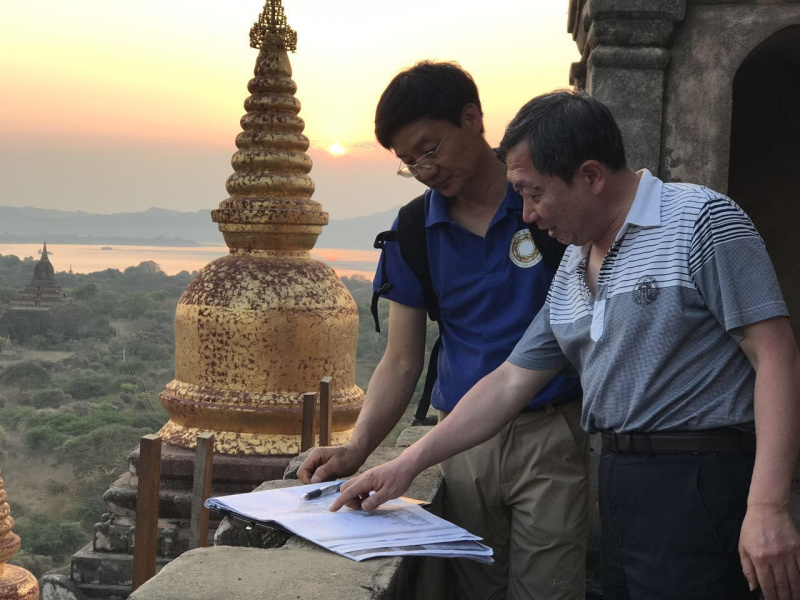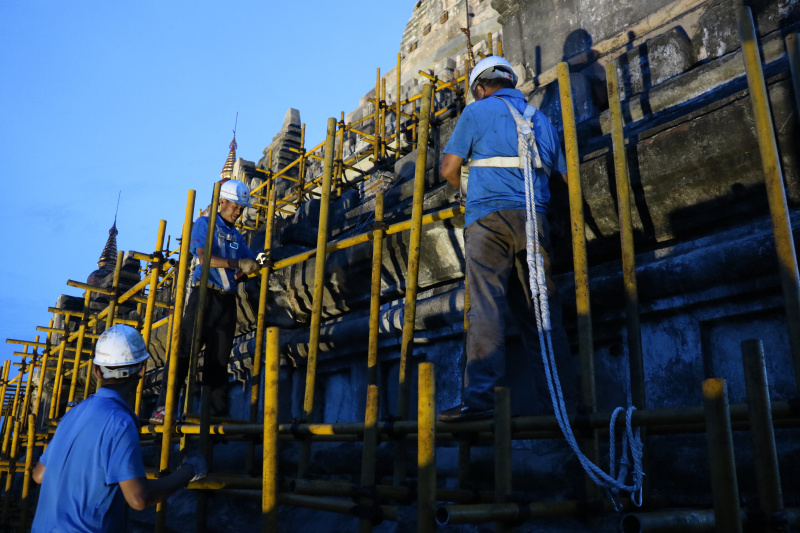
Li Bingnan and his colleague discuss the restoration plan in Bagan, Myanmar. (Photo provided to Xinhua)
Chinese experts spare no efforts to help restore ancient pagodas in Myanmar that were damaged in an earthquake.
KUNMING, Jan. 18 (Xinhua) -- Every time Li Bingnan returns from Bagan, Myanmar, he has to go to the hospital to receive treatment for lower back pain. In a few instances, he was even hospitalized.
The chronic pain, however, never stopped him from working. Li has participated in the post-earthquake restoration of the ancient city of Bagan where a 6.8-magnitude quake damaged 400 famous ancient pagodas and temples in 2016.
As deputy head of the Yunnan Institute of Heritage and Archeology, Li and 11 other Chinese experts were invited to Myanmar to make a preliminary assessment of damage of the pagodas.
"It was both an honor and a test," said Li, who has worked in damage assessment for 30 years.
The Chinese delegation had to survey more than 20 damaged pagodas within a week in temperatures over 40 degrees Celsius.
According to local customs, those who visit the temple must wear pants and remove their shoes and socks.
"It was uncomfortable to walk on the road around the pagoda as it had a lot of debris from the earthquake. Adding in the high tempratures made the work conditions tough," Li recalled.
Born in 1988, Wu Yun was one of the few young archaeologists in the Chinese delegation. "To avoid risks from aftershocks, we had to wear safety helmets all the time," Wu said.
The Chinese delegation would set off at 7:00 a.m. and rest at 11:00 a.m. to avoid the midday sun. Work would resume at 4:00 p.m. and end at 9 p.m.
Many experts were busy with field surveys during the day, which means they spent their nights making reports of their findings. They have been working continuously for several nights, Wu said.

The restoration site in Bagan, Myanmar, June, 6, 2019. (Photo provided to Xinhua)
In less than a year, Li went to Myanmar three times to preliminarily identify China's major assistance projects. In 2018, China and Myanmar signed an agreement in Bagan on assisting in the restoration of the That Byin Nyu pagoda.
That Byin Nyu pagoda, the tallest Buddhist structure in Bagan at more than 60 meters, is highly revered in Myanmar but was "badly damaged and difficult to repair," Li said.
The restoration of the pagoda was jointly carried out by the Yunnan Institute of Heritage and Archeology and Shaanxi Institute for the Preservation of Cultural Heritage.
Myanmar has a rainy season from June to October. In 2019, a team of Chinese experts has carried out emergency waterproofing for the pagoda to prevent secondary damage, said Zhao Qiang, head of Shaanxi Institute for the Preservation of Cultural Heritage.
At present, the preliminary plan for the post-earthquake restoration and protection of the Bagan historic site has been successfully completed.
Bagan was listed as a world heritage site by the United Nations Educational, Scientific and Cultural Organization in 2019.
As for That Byin Nyu pagoda, construction is expected to start in June 2020 with a planned construction period of nine years, Zhao said. ■



